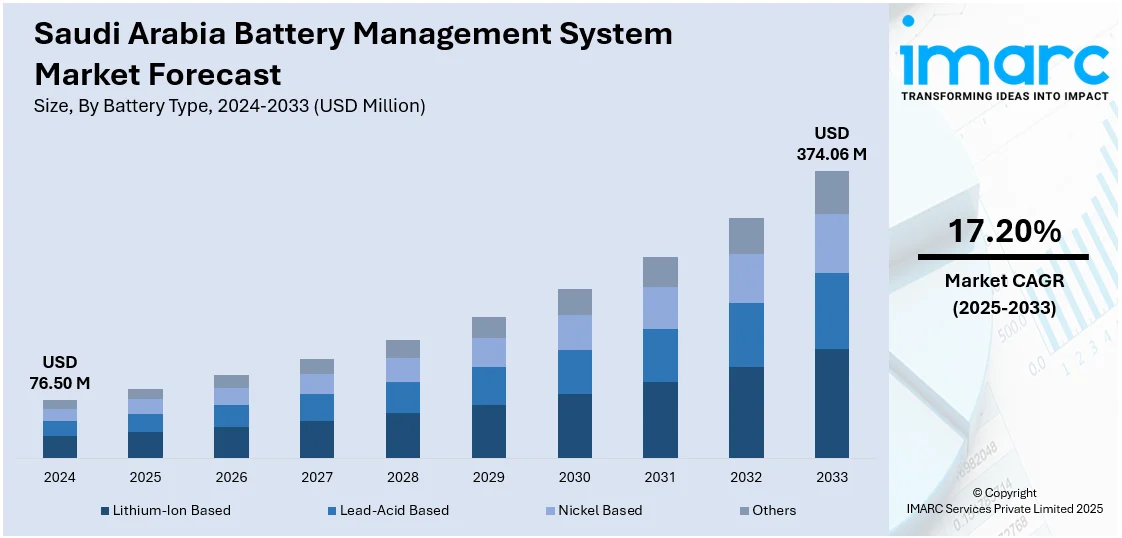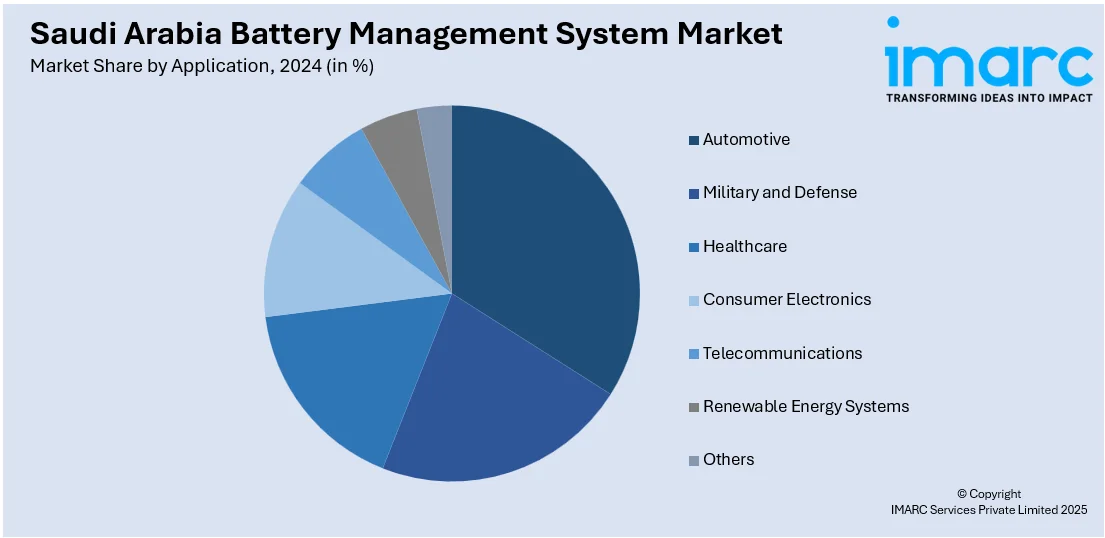
Saudi Arabia Battery Management System Market Size, Share, Trends and Forecast by Battery Type, Type, Topology, Application, and Region, 2025-2033
Saudi Arabia Battery Management System Market Overview:
The Saudi Arabia battery management system market size reached USD 76.50 Million in 2024. Looking forward, IMARC Group expects the market to reach USD 374.06 Million by 2033, exhibiting a growth rate (CAGR) of 17.20% during 2025-2033. The market has seen significant growth driven by the country’s push for renewable energy integration and large-scale energy storage projects. With key initiatives like Vision 2030, the Saudi Arabia battery management system market share is expanding rapidly, supporting grid stability and clean energy goals.
|
Report Attribute
|
Key Statistics
|
|---|---|
|
Base Year
|
2024
|
|
Forecast Years
|
2025-2033
|
|
Historical Years
|
2019-2024
|
| Market Size in 2024 | USD 76.50 Million |
| Market Forecast in 2033 | USD 374.06 Million |
| Market Growth Rate 2025-2033 | 17.20% |
Saudi Arabia Battery Management System Market Trends:
Growing Demand for Energy Storage Solutions
Saudi Arabia is ramping up its investments in energy storage infrastructure, which is significantly boosting the demand for advanced battery management systems market growth. Reflecting this shift, the Saudi Electricity Company (SEC) in January 2025 awarded contracts to deploy 10,000 MWh of battery energy storage systems (BESS) across five strategic sites in the country. This rollout, featuring BYD's battery solutions and EPC support from Alfanar, aimed to strengthen grid reliability and facilitate the integration of renewable energy sources. Implementing such high-capacity storage systems requires intelligent BMS technologies to manage energy flow, monitor charging cycles, and optimize usage during high-demand periods. The market is expanding steadily due to rising needs for efficient, durable systems in large-scale energy initiatives. These technologies are central to the nation's broader strategy of shifting toward sustainable energy by mitigating the fluctuating output of wind and solar sources. As energy storage adoption accelerates, firms are directing substantial resources toward BMS solutions that enhance system performance and minimize energy waste. Saudi Arabia's commitment to reducing reliance on fossil fuels and diversifying its energy portfolio continues to make it a prominent force in the global energy storage landscape. BMS solutions are now critical to long-term success.

Government Initiatives and Market Expansion
Saudi Arabia’s Vision 2030 has laid the groundwork for a fast-growing energy storage sector, driven by the nation’s clear focus on renewable energy. Reflecting this trend, in December 2024, the Saudi Power Procurement Company (SPPC) shortlisted bidders for 8,000 MWh of battery energy storage projects, marking a major step toward cleaner power generation. These large-scale efforts have highlighted the crucial role of battery management systems in maintaining the performance and reliability of storage installations that support the broader renewable energy push. As solar and wind power projects scale up, the need for dependable BMS technology has grown quickly. By regulating how surplus renewable energy is stored and ensuring grid balance during production gaps or peak demand, BMS plays a central role in making storage systems efficient. With the government aiming for renewables to supply half the country’s energy needs by 2030, funding for energy tech, including BMS, is on the rise. The scale of ongoing and planned storage rollouts means BMS solutions must evolve to match new operational demands. This surge in deployment has made Saudi Arabia a key hub for energy storage innovation, reinforcing its drive toward a low-emissions and resilient energy future.
Saudi Arabia Battery Management System Market Segmentation:
IMARC Group provides an analysis of the key trends in each segment of the market, along with forecasts at the country and regional level for 2025-2033. Our report has categorized the market based on battery type, type, topology, and application.
Battery Type Insights:
- Lithium-Ion Based
- Lead-Acid Based
- Nickel Based
- Others
The report has provided a detailed breakup and analysis of the market based on the battery type. This includes lithium-ion based, lead-acid based, nickel based, and others.
Type Insights:
- Motive Battery
- Stationary Battery
A detailed breakup and analysis of the market based on the type have also been provided in the report. This includes motive battery and stationary battery.
Topology Insights:
- Centralized
- Distributed
- Modular
A detailed breakup and analysis of the market based on the topology have also been provided in the report. This includes centralized, distributed, and modular.
Application Insights:

- Automotive
- Electric Vehicles
- E-Bikes
- Golf Carts
- Military and Defense
- Healthcare
- Consumer Electronics
- Telecommunications
- Renewable Energy Systems
- Others
A detailed breakup and analysis of the market based on the application have also been provided in the report. This includes automotive (electric vehicles, e-bikes, and golf carts), military and defense, healthcare, consumer electronics, telecommunications, renewable energy systems, and others.
Regional Insights:
- Northern and Central Region
- Western Region
- Eastern Region
- Southern Region
The report has also provided a comprehensive analysis of all the major regional markets, which include Northern and Central Region, Western Region, Eastern Region, and Southern Region.
Competitive Landscape:
The market research report has also provided a comprehensive analysis of the competitive landscape. Competitive analysis such as market structure, key player positioning, top winning strategies, competitive dashboard, and company evaluation quadrant has been covered in the report. Also, detailed profiles of all major companies have been provided.
Saudi Arabia Battery Management System Market News:
- February 2025: BYD secured a 12.5 GWh battery storage deal with Saudi Electricity Company for five BESS projects. This significant move supported Saudi Arabia’s Vision 2030 by enhancing renewable energy integration. The deal drove demand for advanced battery management systems, expanding the market’s growth potential.
- January 2025: Saudi Arabia launched its largest BESS in Bisha, featuring 2 GWh storage capacity with BYD’s lithium iron phosphate (LFP) batteries. This development significantly boosted demand for advanced battery management systems, driving market growth by enhancing grid stability and supporting renewable energy integration.
Saudi Arabia Battery Management System Market Report Coverage:
| Report Features | Details |
|---|---|
| Base Year of the Analysis | 2024 |
| Historical Period | 2019-2024 |
| Forecast Period | 2025-2033 |
| Units | Million USD |
| Scope of the Report |
Exploration of Historical Trends and Market Outlook, Industry Catalysts and Challenges, Segment-Wise Historical and Future Market Assessment:
|
| Battery Types Covered | Lithium-Ion Based, Lead-Acid Based, Nickel Based, Others |
| Types Covered | Motive Battery, Stationary Battery |
| Topologies Covered | Centralized, Distributed, Modular |
| Applications Covered |
|
| Regions Covered | Northern and Central Region, Western Region, Eastern Region, Southern Region |
| Customization Scope | 10% Free Customization |
| Post-Sale Analyst Support | 10-12 Weeks |
| Delivery Format | PDF and Excel through Email (We can also provide the editable version of the report in PPT/Word format on special request) |
Key Questions Answered in This Report:
- How has the Saudi Arabia battery management system market performed so far and how will it perform in the coming years?
- What is the breakup of the Saudi Arabia battery management system market on the basis of battery type?
- What is the breakup of the Saudi Arabia battery management system market on the basis of type?
- What is the breakup of the Saudi Arabia battery management system market on the basis of topology?
- What is the breakup of the Saudi Arabia battery management system market on the basis of application?
- What is the breakup of the Saudi Arabia battery management system market on the basis of region?
- What are the various stages in the value chain of the Saudi Arabia battery management system market?
- What are the key driving factors and challenges in the Saudi Arabia battery management system market?
- What is the structure of the Saudi Arabia battery management system market and who are the key players?
- What is the degree of competition in the Saudi Arabia battery management system market?
Key Benefits for Stakeholders:
- IMARC’s industry report offers a comprehensive quantitative analysis of various market segments, historical and current market trends, market forecasts, and dynamics of the Saudi Arabia battery management system market from 2019-2033.
- The research report provides the latest information on the market drivers, challenges, and opportunities in the Saudi Arabia battery management system market.
- Porter's five forces analysis assist stakeholders in assessing the impact of new entrants, competitive rivalry, supplier power, buyer power, and the threat of substitution. It helps stakeholders to analyze the level of competition within the Saudi Arabia battery management system industry and its attractiveness.
- Competitive landscape allows stakeholders to understand their competitive environment and provides an insight into the current positions of key players in the market.
Need more help?
- Speak to our experienced analysts for insights on the current market scenarios.
- Include additional segments and countries to customize the report as per your requirement.
- Gain an unparalleled competitive advantage in your domain by understanding how to utilize the report and positively impacting your operations and revenue.
- For further assistance, please connect with our analysts.
 Request Customization
Request Customization
 Speak to an Analyst
Speak to an Analyst
 Request Brochure
Request Brochure
 Inquire Before Buying
Inquire Before Buying




.webp)




.webp)












